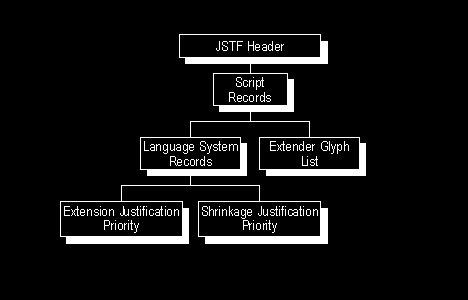Table Organization
The JSTF table organizes data by script and language system, as do the GSUB and GPOS tables. The JSTF table begins with a header that lists scripts in an array of JstfScriptRecords (see Figure 6c). Each record contains a ScriptTag and an offset to a JstfScript table that contains script and language-specific data:
A default justification language system table (DefJstfLangSys) defines script-specific data that applies to the entire script in the absence of any language-specific information.
A justification language system table (JstfLangSys) stores the justification data for each language system.

Figure 6c. High-level organization of JSTF table
A JstfLangSys table contains a list of justification suggestions. Each suggestion consists of a list of GSUB or GPOS LookupList indices to lookups that may be enabled or disabled to add or remove space in the line of text. In addition, each suggestion can include a set of dedicated justification lookups with maximum adjustment values to extend or shrink the amount of space.
The font developer prioritizes suggestions based on how they affect the appearance and function of the text line, and the client applies the suggestions in that order. Low-numbered (high-priority) suggestions correspond to "least bad" options.
Each script also may supply a list of extender glyphs, such as kashidas in Arabic. A client may use the extender glyphs in addition to the justification suggestions.
A client begins justifying a line of text only after implementing all selected GSUB and GPOS features for the string. Starting with the lowest-numbered suggestion, the client enables or disables the lookups specified in the JSTF table, reassembles the lookups in the LookupList order, and applies them to each glyph in the string one after another. If the line still is not the correct length, the client processes the next suggestion in ascending order of priority. This continues until the line length meets the justification requirements.
Note: If any JSTF suggestion at any priority level modifies a GSUB or GPOS lookup that was previously applied to the glyph string, then the text processing client must apply the JSTF suggestion to an unmodified version of the glyph string.
The rest of this chapter describes the tables and records used by the JSTF table for scripts and language systems:
Script information includes the JstfScript table (plus its associated JstfLangSysRecords) and the ExtenderGlyph table.
Language system information includes the JstfLangSys table, JstfPriority table (and its associated JstfDataRecord), the JstfModList table, and the JstfMax table.
